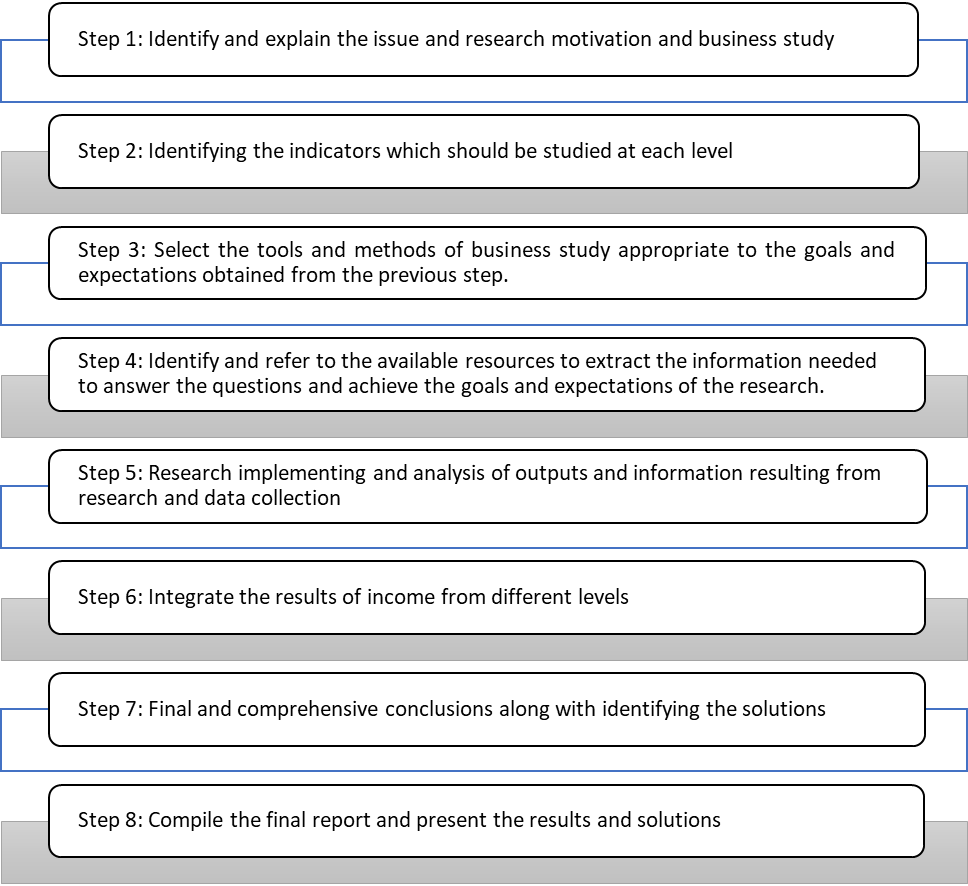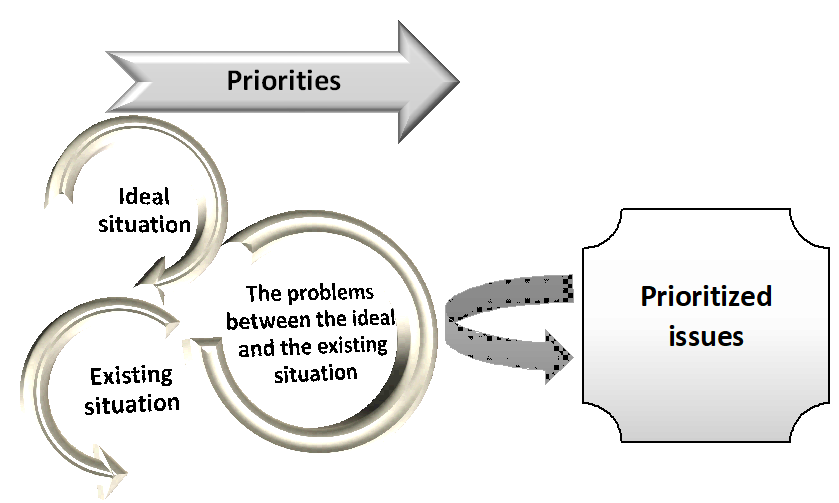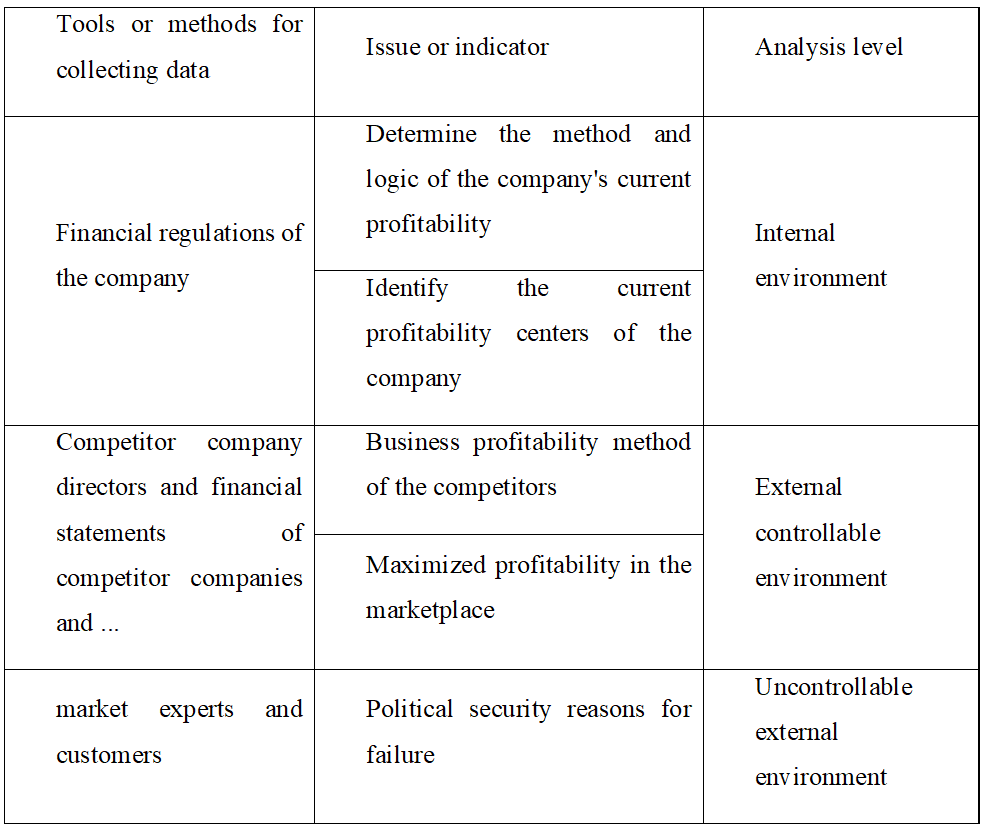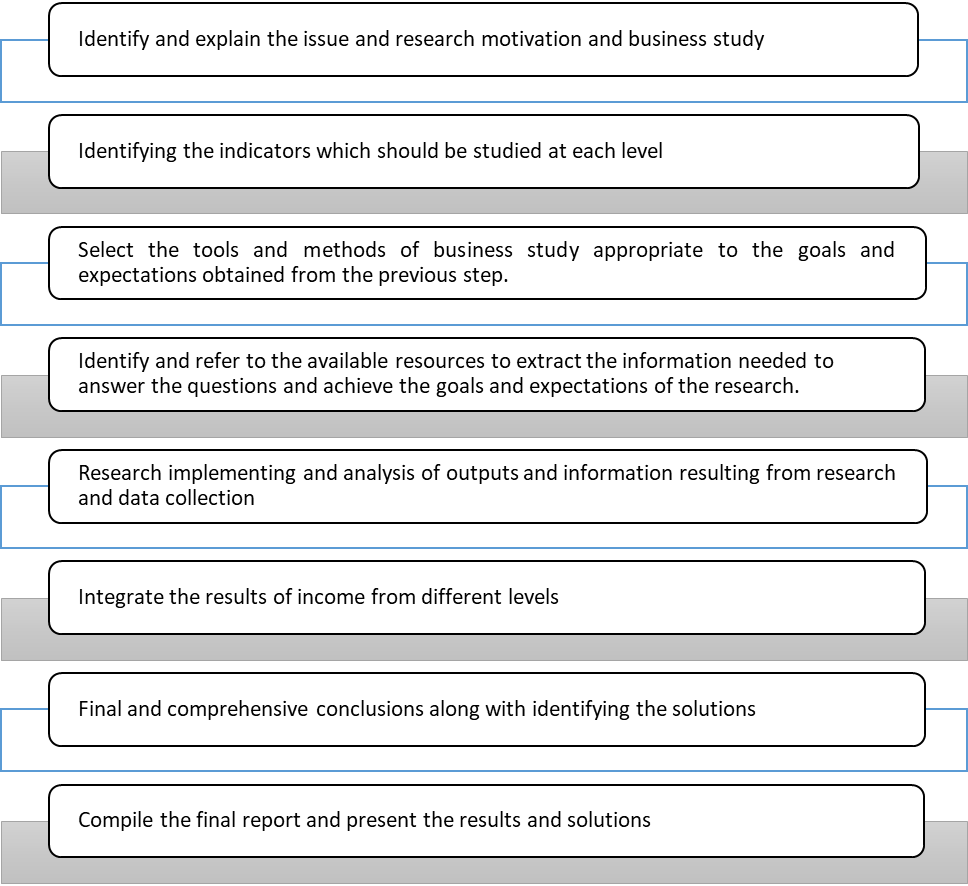International Journal of Business Research and Management
OPEN ACCESS | Volume 2 - Issue 1 - 2025
ISSN No: 3065-6753 | Journal DOI: 10.61148/3065-6753/IJBRM
Maysam Shafiee Roodposhti1*, Hanieh Rezaie2, Mozhdeh Khorram3, Navid Masoumi4
1Corresponding Author and Faculty Member at the University of Tehran.
2Ph.D. Student of Entrepreneurship, University of Tehran.
3M.A Student of Business Administration, University of Science & Art of Yazd.
4 M.A in Tourism Management, University of Science & Art of Yazd.
*Corresponding author Maysam Shafiee Roodposhti, Department of Faculty Member at the University of Tehran.
Received Date: January 12, 2024
Accepted Date: January 15, 2024
Published Date: January 22, 2024
Citation: Maysam S Roodposhti, Rezaie H, Khorram M, Masoumi N,(2024) “Business Research; Framework, Process and Model.” International Journal of Business Research and Management 1(1); DOI: http;//doi.org/112.2024/07.1002.
Copyright: © 2024 Maysam Shafiee Roodposhti. This is an open access article distributed under the Creative Commons Attribution License, which permits unrestricted use, distribution, and reproduction in any medium, provided the original work is properly cited.
One of common mistakes in today's business world is strategic mistake of managers in understanding the business environment in the context of the market concept. Accordingly, the purpose of this study is to achieve a framework for conducting business research projects. In this way, it deals with the business and does not deal with the market research approach. Reported literature suggests that the logic of market literature has focused on the logic of business research. Therefore, in order to achieve this pattern, the available resources were first used to identify the indicators and elements of business research constituents. Then, the proposed pattern was designed and presented according to the reported cases. In the next step, the process was reviewed through the survey and consultation with experts. Eventually, the result of a two-step survey was to achieve a pattern for business research that could make the process in an 8-step platform.
Introduction:
Business research analyze a field of applied studies, which the company collects data and then checks the data in a way that can manage the organization better. Business research is a purposeful and systematic process of collecting, recording and analyzing data that provides information to guide business decisions. This research is intended to understand market trends, optimal marketing, effective human resources policies, or to find the best investment options, and often begin with a market or industry review. The key objective is to determine the available opportunities between particular markets. Business research helps managers to identify their customers' needs and desires and make good decisions about the development of their products and services. This creates an opportunity to recognize competition and helps managers to understand their market and industry completely (Edmunds, 2017). Investigating about business dimensions, such as target customer, marketing methods, production processes and financial activities, helps to anticipate your plans, sales and special opportunities and prevent actual problems. Sereejesh et al, (2014), represented three main patterns of business research, market research, operational research and customer motivation research. "Market, Marketing and Business", is defined in accordance with Longman dictionary, then the difference between market research, marketing research and business research is expressed.) First, the definition of Market, Marketing, and Business is referred to by Longman dictionary ( Market means the time when people buy and sell goods, food and ... or place, usually outside or in a large building where this action is taken. In other words, market means the place of business (Mayor, 2009) and according to the definition of the American Marketing Association, marketing means activities, a set of institutions and processes for creating, communicating, receiving and exchanging suggestions that are valuable to customers, users, partners and in general the community(Aaker et al, 2013). Marketing concept does not focus only on one aspect of it, but in the process of marketing authenticates the individual roles such as customers and suppliers or foreign agencies that regulate marketing. In the Longman dictionary business means the activity of creating money with the production or the purchase of goods or the provision of services.
What is the difference between market research, marketing research and business research?
Market research or research about market is the research about a territory or space and what is happening in the market in order to understand the market and its effects on products. In fact, the work of market research is an analysis of the realm or physical space. This is an issue-centered field, such as when a manufacturer faces a problem with his brand or product. For example, are people interested in this product? Is product price appropriate? What is the rate of market pull for a new product? Research on market penetration (Commerce, Trade and Business) is called marketing research. Marketing Research is an organization that derives from within the organization, while market embraces a macro or micro environment and anything outside the organization. In other words, research that is aimed at influencing an organization within this environment or market is marketing research. For example, ways to increase market share, researching the performance of competitors, brand, etc. In this area there are organizational problems. Business research is when you buy or sell and conduct sales or logistics. This area is wider than market research and examines industry-related research, issues related to the national and international environment. The analysis of the above materials shows that most tendencies are in the field of business research with marketing research approach, while business and marketing are different, and research records indicate that most of them are based on marketing research. This research seeks to provide a business research model. Accordingly, the main question of the research is that what are the components and indicators of business research and its implementation model? In other words, what structure does a real and practical pattern apply to business research in accordance with the definition of business?
Marketing Research:
Marketing research is often considered as a tool for marketers to make better decisions. Marketing researchers are studying and investigating to identify market potential, market share, customer satisfaction, buyer behavior, and also pricing practices, product types, distribution, promotion, and sales (Kotler, 2004). Generally, Marketing Research is the identifying, collecting, analysis, purposeful distribution and systematic information to make decisions related to identifying, solving and opportunities in marketing (Birks et al, 2002 & Malhotra Naresh, 1993). Aaker (2005),believes that marketing research should respond not only to environmental threats and opportunities but also to emphasize orientation in order to achieve sustainable advantage. Barnard (1999). points out that there are two main reasons for the continual development of marketing research. First, the speed of commerce has increased with the availability of computers, digital technology and communication tools. Second, the continual growth of marketing research is a clear task for global operations, as the end of the Cold War has created a new international system of globalization.
Business Research:
The success of any business is closely related to how it controls its affairs. In other words, the proper management of the business will make it grow. In fact, management is the guiding people, influencing work and making decisions in time and correct. Managerial skills must be acquired over the time. In other words, management can be defined as the process of efficient organization of resources for achieving goals, and business management is the use of this process in a specific organization. Business research is the application of the scientific method to search for the truth about the business phenomenon. These activities include the definition of business opportunities and problems, the production and evaluation of the courses of action, assessment of employees and organizational performance. This process involves the idea and the development of theory, the definition of the problem, the search for that problem and the collection of information, the analysis of the data and the relationship between their findings and their inferences. This definition suggests that business research information has not been gathered intuitively (Zikmund, 2013). In addition, business research is a series of company studies to achieve data and analyze them for better company management. This research is used to solve various operational and planning problems occurring in a business organization, including the review of financial data, customer feedback, products and competitor analysis. Suttle(2017), presented that business research often starts with a market or industry review, and its key goal is to determine the opportunities available in a particular market. Business research reduces instability and improves decision-making results. Under various strategic decision-making conditions, such as defining competitive challenges, improving business practices, and finding business opportunities, business research is essential. Despite limited resources, minor business activities are highly vulnerable to strategic decision making mistakes. As a result, most decision-making processes will be essential to small business managers in business research (Zikmund et al, 2009). The business research process represents the examination of all aspects of the company, its customers and markets, then the use of information for business decision making. Basically, the company assesses its strengths and weaknesses, but it particularly emphasizes the attitude of consumers about their products. When company managers evaluate the market, they usually have a comprehensive look at their important competitors and the industry where they are active (briefly, the business research process can be considered as the entire framework of business research). Each business research is first conducted to make effective decisions about the various problems and opportunities identified by the organization. Whenever a company identifies a potential problem or opportunity, it recognizes the need for a research. When the problem is clearly identified, the manager will check whether the information is already there. If such information is easily accessible, the manager will not need to spend a lot of resources to regain the same information. After the exact identification of the problem, it will be defined and then the research objectives are determined. The steps in this process are: identifying the problem or opportunity, planning the research plan, choosing a research method, selecting a sampling method, collecting data, evaluating the data and presenting a research report (Sreejesh, 2014).
Background research:
Many research on business research has been conducted in different branches. For example, Akbari et al. (2005), in a paper entitled "Designing a Model for Classifying and Prioritizing Electronic Business Research Plans in Iran", examines the systematization of electronic business research in the country in general and at the level of the institute of business studies and commercial research. As a result, they have reached a five-year program by classifying the electronic commercial research about each year (Akbari et al., 2005). Table 1 shows some of the most important studies with their results.
Table 1. Summary of previous research results
|
Researchers |
subject |
results |
|
Namazi, M. & Namazi, N.R., (2015) |
Analysis of moderating and mediating variables in business research |
The results indicate that: 1) complex business problems are more transparent by moderating and mediating variables. 2) Without moderating and mediating variables, business models are incomplete and unable to solve barriers to business. 3) Moderating and mediating variables expand the field of business theories. 4) Moderating and mediating variables respond to "when", "how", "why", and the relationship between dependent and independent variables |
|
Olavarieta & Villena, (2013) |
Innovation in business research in Latin America |
The results indicate that increased business research in Latin America and business partnerships are a key to innovation |
|
Shaker, (2015) |
Family business research based on theory of development |
It should discuss the important points and the importance of understanding theory, and the proposed plans require reasoning, analysis and interpretation |
|
Kudlats et al, (2014) |
Correspondence analysis: promising techniques for interpreting qualitative data in family business research |
The results indicate that this article slightly enlarges the knowledge of the qualitative method and provides a preliminary for more clarity of the relationship between the results of family business research projects |
|
Svensson, (2013) |
The processes of proof and theoretical participation through the creation of the theory in business research |
The importance of cumulative processes and participation in business research should not be ignored, but its logic and value is now being argued, which is often ignored or underestimated |
|
Lee & Luo, (2014) |
Reading the road to business research in the west: What is the best way to research business in China? |
Research at the China Business School rejects basic research on the model of scientific research and also selects scientific research as a professional path to the model |
|
Ferraro & Marrone, (2016) |
Investigating the activities related to employment in family business research |
The results indicate that human resources management activities in family businesses are important areas for future research to advance theory and practice |
|
Gorton, (2000( |
The dominance of the agency's component structure in small business research |
The results suggest that the use of social theories and beyond this limited dichotomy, provides a more satisfying framework for the small business sector |
|
Wu & et al,2017 |
Publication of disciplinary knowledge in business research |
The results indicate that quantitative analysis in a large data set containing more than 400,000 business research journals between 1997 and 2009 represents an important pattern in the publication of knowledge in business research |
|
Johnston et al, (1999) |
Test theory using case studies in business research |
The results suggest that case studies can help one of the other tools for marketing a business marketing phenomenon |
Methodology:
In this study, the indexes of business research have extracted with a review of past theoretical foundations as well as previous studies related to the present research, in order to provide a business research model. This study was conducted using the "Developmental Approach" and "Evidence-Based Performance Approach" to upgrade existing knowledge. Developmental research is planning, developing a process, producing, or programming (Asadzandi et al, 2018). The purpose of the developmental research is to provide a more comprehensive introduction of the results of the conducted research and to extend the scope of the studies of this kind of research. The required information for this study was compiled using library method and interview. The related indexes and patterns were extracted by the library studies and using literature in this area. The statistical sample of this study consists of 18 experts familiar with the subject of business, which was conducted through interviewing their comments. Therefore, its process is described in Fig. 1, based on what this research is about.

Figure 1: The process of conducting research
Presenting a Business Research Plan:
As suggested, this research seeks to achieve an appropriate pattern of business research, consistent with the concept of business. Accordingly, in the first step, a review of the history and identifying the indicators of business research has been addressed from the perspective of resources and literature. This work was conducted using the library study method, identifying and extracting the factors and indicators that affect business research.
Checking Records and Identifying Business Constituents:
In order to identify the indicators of business research in the service sector in the qualitative phase of research, the first step was to extract the views of researchers and research sites related to business research about the constituent indicators of business research by a library method. Based on these sources, the factors and indicators that affect business research are extracted, the results of this study are shown in Table 2.
Table 2. The elements of business research in different point of views
|
Sources |
Rick suttle |
Kimberlee Leonard |
S.sreejesh et al |
Ramzan |
Zikmund et al |
|
|
Indicators |
Siddiqui |
|||||
|
Identifying the issue precisely |
|
|
|
|
|
|
|
Having Research Proposal |
|
|
|
|
|
|
|
Refer to the basic and direct data |
|
|
|
|
|
|
|
Refer to secondary and indirect data |
|
|
|
|
|
|
|
Identifying the competitors |
|
|
|
|
|
|
|
Customer analysis and study |
|
|
|
|
|
|
|
Select and study target audiences |
|
|
|
|
|
|
|
Using the appropriate analytical tools |
|
|
|
|
|
|
|
Applicable results |
|
|
|
|
|
|
|
Identifying the existing opportunities and threats |
|
|
|
|
|
|
|
Getting the right research plan |
|
|
|
|
|
|
|
Appropriate sampling method |
|
|
|
|
|
|
|
Collect detailed information |
|
|
|
|
|
|
|
Appropriate analysis method |
|
|
|
|
|
|
|
present a research report |
|
|
|
|
|
|
|
Choosing the appropriate data collection method |
|
|
|
|
|
|
|
Interpreting and analyzing the results |
|
|
|
|
|
|
|
Decision making based on the results and interpretations |
|
|
|
|
|
|
In the end, after analyzing the literature and opinions of the various researchers in the business research process, the following table shows the results of this step. Table 3 covers the stages of the business research process, based on which the research question is addressed.
Table 3: Research Steps:

In the following, each stage is explained with the presentation of the example.
Step 1: Identify and explain the issue and research motivation and business study
Identify the managers' concerns that require the study of the business. This is accomplished by completing the lists, considering the levels of analysis.

Figure 2: Identifying and explaining the problem
From the list above, the issues that relate to the three-level business environment are selected in order of priority and entered into the analysis process. Please note that the above items may be targeted by a gap, such as not achieving high profits. Therefore, they should become an issue to be researched. For example, for the above purpose, the methods of combining business cases are the research issue.
Step 2: Identifying the indicators which should be studied at each level
This step seeks to identify the indicators and patterns that, by examining them, can be used to answer the problems of the business research process from the previous step. In fact, the output of this step is the form of questions and considered indicator in order to answer the main research question. For example, for a problem called profitable methods of competitive and non-competitive businesses in the market, indexing and questions are suggested as follows.
Indicators and tips to be asked about the internal environment:
Indicators and tips to be asked about the related external environment:
Step 3: Select the tools and methods of business study appropriate to the goals and expectations obtained from the previous step.
At this step, each of the questions is proposed in table 4 and appropriate tools and methods for collecting data to respond to them are suggested.
Table 4: Tools selection guide and business study method

Step 4: Identify and refer to the available resources to extract the information needed to answer the questions
At this step, the sources and criteria for collecting data are introduced and the data collection loop is completed. In the second step, the indicators to be studied, and in Step 3, the tools and techniques or methods to be used for data collection should be introduced. At this stage, as the final step of the important process of research, the successful resources and databases that can be used to collect data are referred to the researcher. Table 5 is the guide for this step.
Table 5: Guide for extracting necessary information to answer questions

Step 5: Implement research, data and information collection and analyze the results
This step is the implementation phase of the study, and by collecting data from three pillars, as well as the form of the main question, it is necessary to survey through the field and collect data. This step is the implementation part of the research, linking the implement steps with the analytical steps of the research. It is difficult to model and frame it due to the various reasons and contingency of this step. In fact, this is the step in the use of various research methods, statistical tools and data collecting tools.
Step 6: Integrate the results of income in different levels
Since the structure of this approach follows the research from a number of levels and according to different perspectives, this step provides a complementary step for the survey phase and data collection. Accordingly, in this step, it is tried to align the achieved results in a combined action through the analysis of each question. In fact, in this step, the potential mismatch in the outputs of each level or the question that is due to differences in views is aligned and the ambiguities are clarified.
Step 7: Comprehensive conclusions along with providing solutions
The final step is to study this stage. At this stage, the researcher is involved and the final conclusion of the analysis and the presentation of the solutions are analyzed as a consequence based on the types of data obtained from the previous steps. In fact, the main goal of business research is this step and its output is to answer the needs of the owners of the issue.
Step 8: Compile the final report and present the results and solutions
The structure of all such systems, such as market research, applied research, etc., is completed by this step that the project delivers to the employer. Therefore, this step is more formal and structured and has certain advantages that can be exploited.
Discussion and conclusion:
Regarding previous studies that have examined the effects of other effective variables in business research, including independent variables such as innovation (Olavarieta et al, 2013), mediator and moderator variables (Namazi et al, 2015). In this research, it has been presented an analysis of the existing gap (the difference of marketing research and business research) and by answering the research question, the following model is proposed for business research. The pattern expressed in this study can be applied or extended by other researchers and ultimately compared to market research. The pattern of business research is shown in Figure 3.

Figure 3: Business Research Patterns
Conflict of Interest: On behalf of all authors, the corresponding author states that there is no conflict of interest.